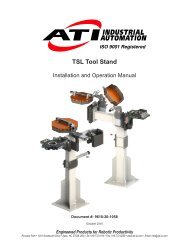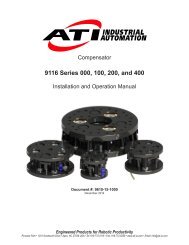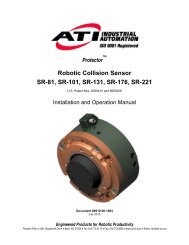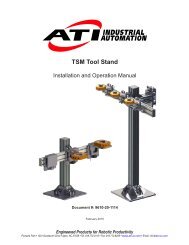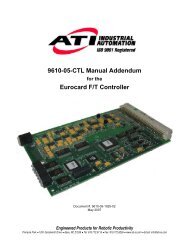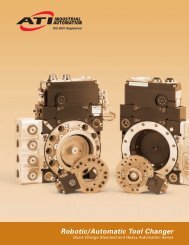Network Force/Torque Sensor System
Net F/T Manual - ATI Industrial Automation
Net F/T Manual - ATI Industrial Automation
You also want an ePaper? Increase the reach of your titles
YUMPU automatically turns print PDFs into web optimized ePapers that Google loves.
Net F/T Installation and Operation Manual<br />
Document: 9620-05-net ft-11<br />
17. Advanced Topics<br />
17.1 Improving Ethernet Throughput<br />
In an optimum network setup, the Net F/T’s RDT data will arrive at the host computer with no loss of<br />
data<br />
If you observe lost data samples, you may do one or all of the following:<br />
17.1.1 Direct Connection between Net F/T and Host<br />
To achieve the best Ethernet performance (and avoiding the loss of data packages), we<br />
recommend connecting the Net Box directly to the host computer. If you need to use a switch,<br />
then try to use only one switch between sensor system and host. Avoid going through several<br />
switches or going through a hub.<br />
17.1.2 Choice of Operating <strong>System</strong><br />
The Windows operating system periodically performs housekeeping processes that can require<br />
a significant amount of processing power over a short amount of time. During these intervals, a<br />
loss of data can occur because Windows does not treat UDP data with a high enough priority.<br />
If a loss of data is not acceptable for your application, then the use of a real-time operating<br />
system is recommended.<br />
17.1.3 Increasing Operating <strong>System</strong> Performance<br />
The following items may also help you increase the performance of your computer system so it<br />
can best respond to the Net F/T’s fast data rates:<br />
Disable software firewall. One way to improve the Ethernet performance is not to have any<br />
software firewall activated. In some cases, this may require help from IT personnel.<br />
Disable file and printer sharing. The processes associated what file and printer sharing can<br />
slow down an operating system’s response to Ethernet data and may lead to lost data.<br />
Disable unnecessary network services. Unnecessary network services and protocols can slow<br />
down an operating system’s response to Ethernet data and may lead to lost data. For the best<br />
UDP performance, it may be necessary to turn off every network service except for TCP/IP.<br />
Use an Ethernet traffic snooper. An Ethernet traffic snooper can be invaluable in detecting<br />
that there are processes using up Ethernet bandwidth and potentially slowing down the<br />
response of your computer’s operating system. This is an advanced technique that your IT<br />
department may need to perform. The free software program Wireshark (www.wireshark.org)<br />
is commonly used for this type of investigation.<br />
Use a dedicated computer. A dedicated measurement computer isolated from the company<br />
network will not be burdened by the company network processes.<br />
Use the Net F/T’s multi-unit synchronization capability if there are multiple Net F/Ts on the<br />
same network. This will eliminate data collisions from Net F/Ts transmitting at the same time.<br />
17.1.4 Avoid Logging the Host to a Company <strong>Network</strong><br />
Being logged onto a network requires the periodic access to the Ethernet interface by processes<br />
other than your measurement application. This can lead to loss of UDP packages.<br />
17.1.5 Use a Dedicated <strong>Network</strong><br />
Placing the Net F/T on a dedicated Ethernet network with no other devices on the network,<br />
other than the host computer, will remove data collisions and give the best network<br />
performance.<br />
Pinnacle Park • 1031 Goodworth Drive • Apex, NC 27539 USA • Tel: +1.919.772.0115 • Fax: +1.919.772.8259 • www.ati-ia.com • Email: info@ati-ia.com<br />
B - 96



